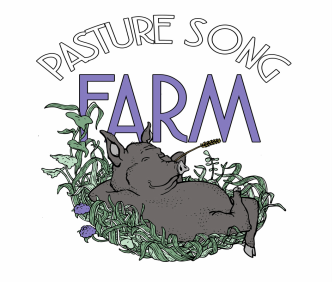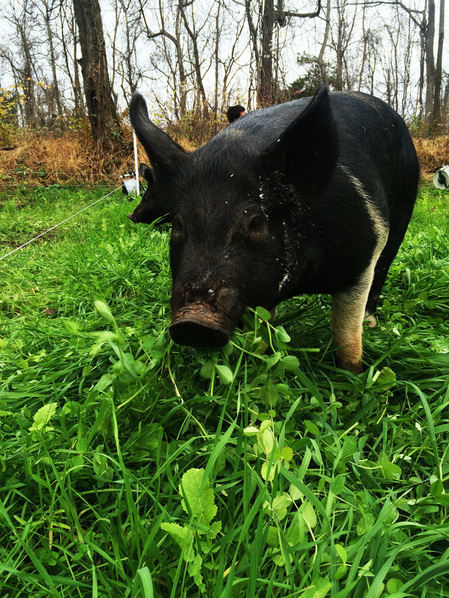What is Forage Grazed Pork?
We think it is important to describe our hogs as "forage grazed" instead of "pastured," because it better describes what we do.
Forage grazed is a more encompassing term. It includes not only grazing pasture grasses and legumes, but also cultivated forage crops (e.g. small grains, peas, turnips, etc.) and "mast" (e.g. acorns, berries, fruit, etc.).
Hogs eat a diverse diet, and, unlike ruminant animals, they cannot live exclusively on grass. Because of this, we cultivate a variety of crops and herbage for our hogs to graze. This way more of their dietary needs are being met by the pasture. We also feed them local non-GMO grain and organic yogurt, to ensure they're getting everything they need.
We view "forage" as an integral component of our pigs' diets. We don't simply turn hogs into a pasture for a long period of time, during which they can cause excessive disturbance, nutrient loading, and compaction. Instead, we actively manage the forage resource by frequently moving our pigs to new paddocks. We cultivate specific crops, such as buckwheat, oats, corn, peas, and more. When our hogs graze these crops, we are maximizing the feed value of our pastures.
This is beneficial in many ways. Our hogs get more nourishment from the pasture, providing them with a healthful, diverse diet. This translates into healthier pigs, and healthier meat! The flavor of the meat is also enhanced with a diverse, healthy diet. The forage infuses the fat of the meat with its subtle flavor and aroma. A hog finished in the autumn on apples will have a different flavor than a hog finished in the spring on oats and peas.
Hogs prefer to forage for their own food, rather than being given their feed exclusively. They don't like to be "welfare animals" as Allan Nation, editor of Stockman Grass Farmer, has said. Foraging allows our hogs to express their natural behavior, which helps them stay healthy and stress free. All that exercise also enhances muscling, which is important in producing good pork. Forage grazing lets pigs do what they do best!
Forage grazed is a more encompassing term. It includes not only grazing pasture grasses and legumes, but also cultivated forage crops (e.g. small grains, peas, turnips, etc.) and "mast" (e.g. acorns, berries, fruit, etc.).
Hogs eat a diverse diet, and, unlike ruminant animals, they cannot live exclusively on grass. Because of this, we cultivate a variety of crops and herbage for our hogs to graze. This way more of their dietary needs are being met by the pasture. We also feed them local non-GMO grain and organic yogurt, to ensure they're getting everything they need.
We view "forage" as an integral component of our pigs' diets. We don't simply turn hogs into a pasture for a long period of time, during which they can cause excessive disturbance, nutrient loading, and compaction. Instead, we actively manage the forage resource by frequently moving our pigs to new paddocks. We cultivate specific crops, such as buckwheat, oats, corn, peas, and more. When our hogs graze these crops, we are maximizing the feed value of our pastures.
This is beneficial in many ways. Our hogs get more nourishment from the pasture, providing them with a healthful, diverse diet. This translates into healthier pigs, and healthier meat! The flavor of the meat is also enhanced with a diverse, healthy diet. The forage infuses the fat of the meat with its subtle flavor and aroma. A hog finished in the autumn on apples will have a different flavor than a hog finished in the spring on oats and peas.
Hogs prefer to forage for their own food, rather than being given their feed exclusively. They don't like to be "welfare animals" as Allan Nation, editor of Stockman Grass Farmer, has said. Foraging allows our hogs to express their natural behavior, which helps them stay healthy and stress free. All that exercise also enhances muscling, which is important in producing good pork. Forage grazing lets pigs do what they do best!

